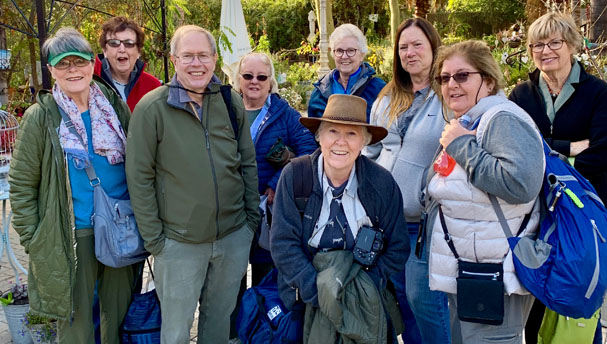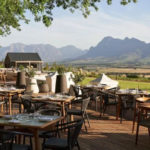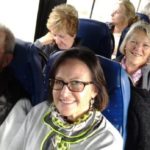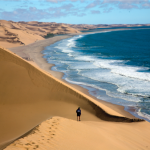Flower Tour 2019
Tour Leader Jim’s Reports

26th August ’19
Extremely few Americans come to South Africa to do what my nine travelers and I are doing right now in Clanwilliam in the Cedarberg Mountains. Most Americans believe “Africa” means “lion” and little else.
Lions are one of my principal passions, but particularly when pursued in southern Africa I actually think there are other kinds of attractions that are more interesting and exciting. Like …flowers.
This was our first day on the spring wild flower tour and it was fabulous! Let’s start with some eye-openers for you.
The day began at 29 degrees Fahrenheit. That’s just a tad below normal. In the course of our bus drive about 150 miles north of Cape Town the sun managed to come out a few times and warm up the veld to the low 60s.
The scenery was spectacular: There aren’t grand alpine or Colorado mountains in South Africa but there are Arizona mountains and now they are either lush green with winter wheat or solid yellow with nearly feral cannola.
When we finally reached a good spot for thousands and thousands of wild flowers, we stopped the bus and walked into what seemed an unbelievable movie set. Four people in the group are from southern California and three from Texas, and all of them enjoy their own profusion of wild flowers but today really excited them all.
The Cape Floral Region is the smallest of the six kingdoms and is probably the most unique and not only for its size. The wild flowers that we’re now seeing depend like all wild flowers on good rainfall for germination, but many of the Cape’s wild flowers also require hard freezes after budding, something that destroys most budding plants elsewhere.
The sub region that we’ll have the time to explore is the Fynbos biogeographical area in which thrive the most unusual, endemic plants you can imagine.
The standard way a plant matures in most of the world is with spring and summer season rains. In most of the Cape Floristic region, and principally in this Fynbos area, it’s upside down. Rains come in winter. Sleet is rare and snow extremely rare, but freezing temperatures especially at night and very cold rain are common.
As winter passes into spring and then into summer, the rains stop entirely. The summer is awfully hot and completely dry. The wild flowers drop their seeds on a parched and dusty earth, “over-summering” so to speak, compared to the rest of the world’s wild flower seeds “over-wintering.”
Harvest them, nurture them in appropriate soil and give them some water and … nothing will happen. They have protected themselves against the scorching heat and dry, but they won’t come to life without at least a couple very hard freezes!
In the next couple days our flower experience will grow even more beautiful as we head even further north into the interior. Meanwhile, there are other wonders of the Fynbos Kingdom.
Like Rooibos tea! Rooibos is a needle-leaf fynbos plant that when it dies turns red. “Rooi” is ‘red’ in Afrikaans and ‘bos’ is bush. Ergo Trader Joe shoppers, Red Bush Tea.
We had a wonderful tour at one of the larger Rooibos processing plants in the area, the Bergendahl. We spent a good amount of time tasting all sorts of varieties.
We then enjoyed a fabulous three-course lunch of trout and lamb and sponge puddings where various Rooibos teas and various local wines were paired with the food.
South Africans believe Rooibos cures evil, heart ailments and misguided politics. There are varieties for infants, toddlers, teens and old men. It’s also a very contentious issue on the world stage where the government of South Africa has so far successfully stopped Nestle from synthesizing the Rooibos molecule for patent use.
Along the way at every stop we’re meeting and interacting with South African teachers and farmers and baristas that just never see an American tourist! That’s fun in itself! Lots more to come. Stay tuned!
28th August ’19
I asked our guide how rare were some of these flowers? He almost whispered, “There are only 8 plants left on earth of our rarest.”
And no, we couldn’t be shown that. The location of the plants is a state secret. But he would show us his second rarest, only 382 left, the euryops virgatus. Compared to all the other beauties it wasn’t memorable: a kind of scraggly yellow dot-flower weed.
But it made me think of the only other thing so rare that I ever once saw. I was one of the first to trek to see the mountain gorillas, at the time there were less than 350. There are now nearly 1300, so good luck to the scraggly yellow plant!
What fun we’ve been having in the western and northern Cape! Our first game drive in an open Landrover was to see flowers! Sixth generation sheep farmer Wilhelm Van Wyk gave us a private tour of his thousand-acre Papkuilsfontein farm.
It was cold! 42F when we arrived but 28F the night before. But in the glamorous sunshine his fields of yellow wildflowers were unbelievable!
Then to the wonderful Hantam Botanical Park with an outstanding guide who recently had his name given to a new little fly that specifically pollinates one rare wild flower. There are more than 1200 species of wild flowers carpeting the remote western and northern Cape right now and 900 are endemic, 30% in the IUCN risk categories mainly because of climate change.
We learned of dozens of odd and beautiful plants but the one that really caught our attention was gorteria diffusa, a 12-pedal orange plant with two chocolate drops on two of the pedals. What are they? Exact replicas of the one type of beatle that pollinates them! Just to make the bug feel welcome…
Then to the Clanwilliam flower show. This is not like an American flower show. Volunteers spend these two months traveling all over the area and even into Namaqualand to gather wild flowers from the root up, preserving them in an amazing display of living beauty in the Clanwilliam church!
The beauty is exceptional, but the work these volunteers do for a show that lasts only 6 days a year is extraordinary!
Lots of wonderful people all along the way. Outstanding (too much) food and beauty indescribable. We’ll see our big animals, soon, but there’s a lot more to Africa than lions!



